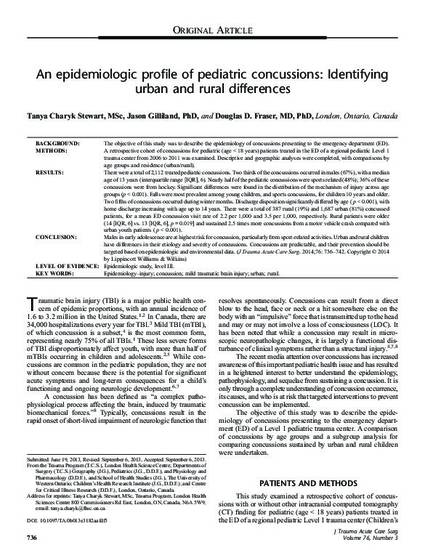
BACKGROUND: The objective of this study was to describe the epidemiology of concussions presenting to the emergency department (ED).
METHODS: A retrospective cohort of concussions for pediatric (age G 18 years) patients treated in the ED of a regional pediatric Level 1 trauma center from 2006 to 2011 was examined. Descriptive and geographic analyses were completed, with comparisons by age groups and residence (urban/rural).
RESULTS: There were a total of 2,112 treated pediatric concussions. Two thirds of the concussions occurred in males (67%), with a median age of 13 years (interquartile range [IQR], 6). Nearly half of the pediatric concussions were sports related (48%); 36% of these concussions were from hockey. Significant differences were found in the distribution of the mechanism of injury across age groups (p G 0.001). Falls were most prevalent among young children, and sports concussions, for children 10 years and older. Two fifths of concussions occurred during winter months. Discharge disposition significantly differed by age ( p G 0.001), with home discharge increasing with age up to 14 years. There were a total of 387 rural (19%) and 1,687 urban (81%) concussed patients, for a mean ED concussion visit rate of 2.2 per 1,000 and 3.5 per 1,000, respectively. Rural patients were older (14 [IQR, 6] vs. 13 [IQR, 6], p = 0.019] and sustained 2.5 times more concussions from a motor vehicle crash compared with urban youth patients ( p G 0.001).
CONCLUSION: Males in early adolescence are at highest risk for concussion, particularly from sport-related activities. Urban and rural children have differences in their etiology and severity of concussions. Concussions are predictable, and their prevention should be targeted based on epidemiologic and environmental data.
Available at: http://works.bepress.com/douglas-fraser/35/

Also available open access in Journal of Trauma and Acute Care Surgery at: https://doi.org/10.1097/ta.0b013e3182aafdf5